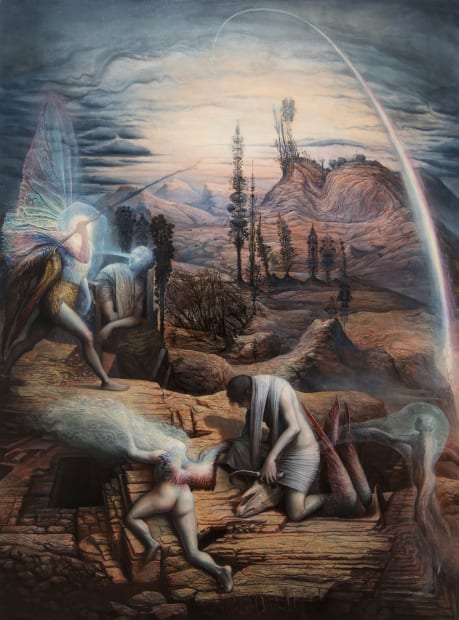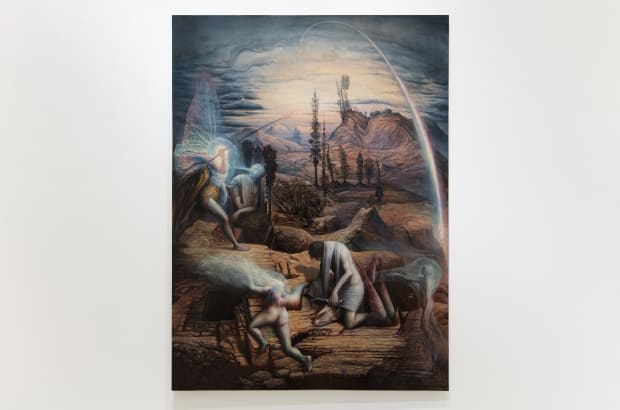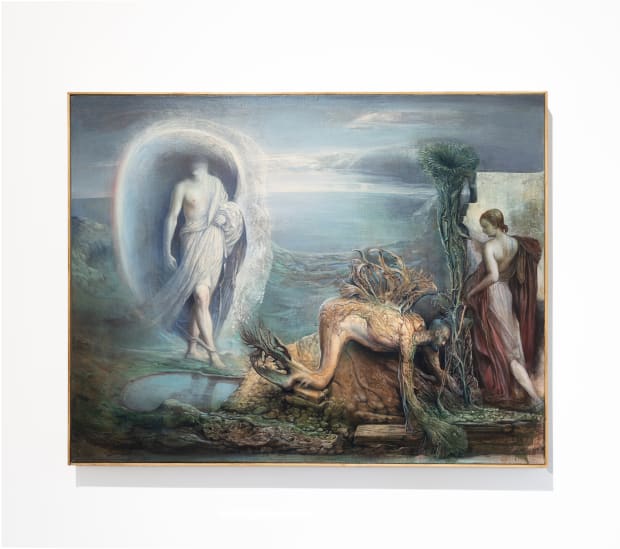-
Primo Marella Gallery Lugano is pleased to present the new exhibition by Agostino Arrivabene, entitled "Aprire le Zolle. Visioni dal Sottosuolo". Through a play of references between light and shadow, birth and transformation, the artist explores the power of a creative act rooted both in the earth and in the depths of the human soul.The title of the exhibition draws inspiration from one of Alda Merini's most emblematic poems, "Sono nata il ventuno a primavera", which celebrates rebirth and storm, the meeting between the invisible and the visible. In this profound dialogue with the poetess, Arrivabene traces a symbolic line connecting the spring equinox to the summer solstice, two extremes of a cycle that are reflected in the artistic gesture as a hypotenuse of love."Aprire le zolle" is not just a physical act but a metaphysical gesture: to dig, to till, to bring to light what has remained hidden. The works on display seem to germinate from fertile soil, bringing visions to the surface that traverse the underworld and touch upon the unconscious, the tragic, and the mystical. Like Persephone, the goddess who walks between worlds, the artist invites the viewer to discover a realm where light and shadow merge into an abyss of meanings and revelations.It is an invitation to immerse oneself in a journey that goes beyond the surface, to rediscover the primal force of creation and existence.
-

-
The grafting of real flowers, collected, dried and integrated into the pictorial surface, is an act of love but also of illusion: the real is hidden in fiction, still life comes to life, in a kind of “animated herbarium” where the botanical datum is intertwined with the mythical vision.The face at the center of the work is not a portrait: it is an icon, a simulacrum of expectation. An archetypal figure, severe and mute, that seems to hold within itself the secret of a suspended flowering. It is nostalgia itself that takes shape - like a floral statue, or a ritual mask of lost time. In the watermark, one senses a broader and more mournful reflection on beauty: condemned to blossom again and then fade away, never to be wholly presence, but always a dream.On the symbolic and mythological level, Choré no longer appears as the victim of rapture, but as the priestess of her own life cycle. The flowers that crown her are not born from light, but from the memory of it; they do not beget children, but inner seasons. The roots that emerge from her breast, the flowers that bloom from cracks and veins, speak of an inverse motherhood: Persephone is daughter and mother together, and perhaps Demetra also reinvents herself in her daughter's dream.As one of the poetic suggestions related to the work states:"Spring is no longer a return, but a silent delirium beneath the earth. A flower born in the sleep of the abyss.A mother giving birth to her own mother."“L’erbario” is thus much more than a painting: it is a plant song of absence, an altar for time that does not pass but transfigures itself.
-
-

-
On her robe weigh the gifts and losses: magnolias and roses, offerings to the Earth and to the Mother who was left behind in the mythical rapture; roots, thistles, dark and moist buds as fruits of the soil that Persephone fertilized with her own exile. The hands of the goddess seem to ema- nize and at the same time collect these emblems, as if her flesh itself germinated vegetation, in a process of identification with soil and memory.Also crucial is the pictorial origin of this painting: the sacred image of the goddess literally arises on the burial of an earlier work, a sketch of the Great Mysteries, thus becoming a palimpsestic icon, a simulacrum grown on the body of the past, like a flower germinating from a tomb. This datum is not secondary, but rather fundamental to the reading of the work: Persephone then becomes an epiphany of layering, a body-goddess grown on the layer of mystery, on buried myth, on redeemed and regenerated painting.The work is an altar of silent power, and the viewer is not spectator but officiator. In it are united: Leonardesque classicism, visionary naturalism, the psychic alchemy of matter, and the memory of one's previous pictorial gesture, which is not erased, but transfigured into the sacred.
-
-
The myth of Persephone
The myth of Persephone is one of the most fascinating and symbolic tales in Greek mythology, deeply connected to natural cycles and the changing of the seasons. Persephone, daughter of the goddess Demeter, lived a serene life among flowers and light until the day Hades, god of the Underworld, abducted her to make her his bride. Demeter's grief over her daughter's disappearance was so profound that it interrupted all life on earth: the fields stopped bearing fruit, the earth dried up, and mankind was struck by famine.Only Zeus' intervention led to a compromise: Persephone would spend six months of the year in Hades with Hades, and six months on earth with her mother. From this alternation comes the mythological explanation of the seasons: autumn and winter correspond to her descent into the underworld, while spring and summer mark her return and the rebirth of nature. -
-

-

-
On the left, a winged, mighty, hieratic figure-perhaps an angel, a genie, or a personification of fate-seems to be guiding the doom with solemn and irrevocable gesture. His face is bathed in a luminescent aura reminiscent of the clouds of ancient divinatory apparatuses, while his hand holds a cosmic spear or scepter that directs the course of events.In the background, a layered desert landscape, marked by thin, threatening trees, opens beneath a sky traversed by an arc of light: a rainbow that, far from being a sign of biblical covenant, seems here to be the ironic or sublime counterpoint to the fall - an inverted trajectory that accompanies the precipitation of the soul.
The work is rooted in the myth of Daedalus and Icarus, but reinterprets it through an expiatory and cruel lens, similar to that of a tragic post-orphism. Daedalus, not directly represented here, is evoked as a blind demiurgic force, a technical Prometheus who sacrificed his son for the perfection of flight. The “collector of wings,” a central figure and at once judge, executioner, and archivist of winged impiety, represents the inevitable consequence of the sacri- lego gesture: he collects the evidence, the bodily signs, of failed challenges against the divine order.
Icarus' winged emasculation is a powerful image that overturns the aesthetics of flight as freedom to convert it into condemnation: technique, taken beyond the limit, does not elevate but mutilates. Icarus' body, slipped into spectral transparency, becomes a symbol of the soul that dissolves when hybris reaches its peak. The entire composition then appears as a liturgy of failure, a theurgical theater of the fall, in which the Collector preserves wings as blasphemous relics of an outrage against the divine.
The angel or winged genie can be read as a punitive Daimon, a spirit that accompanies and leads the soul to its destination-not as a saving guide, but as a jailer of the cosmic order. Is he perhaps the executor of the verdict, or the heavenly shadow of desire that drove Icarus toward the sun?
-

-
-
By immersing himself in the works housed in museums across Europe and beyond, Arrivabene developed a deep, intuitive understanding of classical art.His creative pursuit revolves around a search for continuity—a thread linking the aesthetics and poetics of the past with the contradictions of the contemporary world. His art reflects a deliberate return to the values of beauty and spiritual depth, often lost in modern artistic discourse.Profoundly inspired by the Old Masters—Leonardo da Vinci, Albrecht Dürer, Jan van Eyck, the Flemish Primitives, and Rembrandt—Arrivabene forged his own artistic path, rejecting modernity in favor of ancient techniques and sensibilities. Through years of self-directed study, he revived traditional methods of painting, including the artisanal preparation of pigments and materials, many of which had long fallen into disuse.His artworks are marked by a visionary intensity and a rich symbolic language. Working with rare and hand-prepared materials, Arrivabene blends mystical and allegorical elements into dreamlike compositions. His imagination draws heavily from Renaissance and Baroque collections of "Naturalia, Mirabilia et Artificialia"—an eclectic universe populated by strange animals and curious objects, echoing the cabinets of wonder (Wunderkammern) of the past.
-

-
-

-
AGOSTINO ARRIVABENE
APRIRE LE ZOLLE - VISIONI DAL SOTTOSUOLO
PRIMO MARELLA GALLERY LUGANO
21 JUNE - 31 JULY 2025












